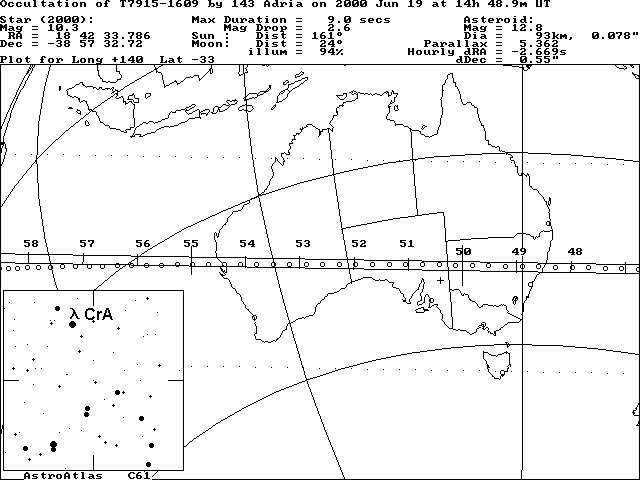ASTROMETRIC UPDATE:
OCCULTATION BY (143) ADRIA - 2000 JUNE 19
THIS UPDATE REPLACES THE PREVIOUS UPDATE OF 12 JUNE.
CHECK THIS PAGE REGULARLY FOR FURTHER UPDATES AND CHANGES TO THE TRACK.
YOU MUST RELOAD THIS PAGE USING YOUR BROWSER'S
RELOAD/REFRESH BUTTON TO OBTAIN UPDATES!
[Prediction by Edwin Goffin]
[Prediction using OCCULT software]
[Detailed finder chart by Jan Manek]
Goffin's path crosses the northern New South Wales coast just north of Newcastle running west to cross the Western Australian coast near Carnarvon. The OCCULT path lies around 0.4" to the north and around 1 minute earlier. It passes just to the south of Brisbane and runs to the Western Australian coast between Onslow and Karratha.
UPDATE: 15 June 2000
This prediction update has been computed by Jan Manek of the Stefanik Observatory based on astrometry from Ron Stone of the US Naval Observatory - Flagstaff Station. The Tycho-2 position of the target star has been used.
Summary:
The updated path lies around 0.5 of a path width to the south and around 0.1 minutes earlier than that given by Edwin Goffin. The path crosses the New South Wales coast near Taree (14:48:30 UT), running just north of Broken Hill (14:51 UT) and crossing the Western Australian just south of Carnarvon (14:54:30 UT). Newcastle and the northern suburbs of Sydney lie within the error bounds of this update. Note that in the map below, the circles represent the centre-line of the path rather than the time graduated lines.
The target star is the northern and brighter component of a close (seperation = 12") pair with TYC 7915 01589 (mag = 10.5). This detail is NOT visible in the predictions prepared by Edwin Goffin but is shown in a second finder chart attached to this update.
In order to detect the occultation, observers must clearly seperate the components of this close pair and monitor the northern component seperately.
THE EVENT AT ONE GLIMPSE:
- Date and approx. UT time of event: June 19, 2000 @ 14:49 UT
- Magnitude of target star: 10.3
- Magnitude drop [mag]: 2.6
- Estimated maximum duration [s]: 9.0
- Path description: See above.
- Goffin's original chart reference: A00_0611
The Occultation Path:
- Approximate width [km]: 95
- Uncertainty [path widths]: 2.6
- Uncertainty in time [s]: 25
- Map: See below
- Remarks: Uncertainities are given on the basis of the nominal star position errors and the expected asteroid positional accuracy.
- Circles along the path are OCCULT calculated exact centerline points.
Data for the target star:
Data for the minor planet:
- Number, name: (143) Adria
- Approx. diameter [km]: 93
- Source of used astrometry: US Naval Observatory - Flagstaff Station (Ron Stone)
- Number of used observations: 35
- Number of rejected observations: 3
- Time covered by the observations: 1997 11 09 - 2000 06 07
- RMS residuals ["] (RA,DE): 0.12", 0.14"
- Estimated positional accuracy at epoch of event ["]: 0.16"
- The recent astrometry for this asteroid has shown a larger than usual scatter due to the southerly declination.
Data for the event:
- UT date and time of least geocentric approach: 2000 June 19, 14:48.9 UT
- Approx. V mag of minor planet at event [mag]: 12.8
- Geocentric parallax of minor planet ["]: 5.362
- Magnitude drop [mag]: 2.6
- Estimated maximum duration [s]: 9.0
- Apparent motion of minor planet ["/h]: 31.14
- Angular distance to moon, phase of moon [deg,%]: 24, 94%
- Update computed by: Jan Manek, Stefanik Observatory, Prague, Czech Republic.

IMPORTANT NOTE!
Astrometric updates such as these should not be taken as definitive, but rather only as an indication of where the true track may lie relative to the original predicted track. Observers must bear in mind that later astrometry, in which the target star is measured in the same field as the asteroid, may still reveal substantial changes to the predicted track and time of the event. For this reason it is most important that observers far from the predicted track still monitor the event.
Use these links for further information:
[Planetary Occultations]
[Using the Predictions]
[Observing Details]
[Timing Details]
[Reporting Details]
[Report Form]
[Asteroid Occultation Results]
This page may have been updated since 15 June 2000.
Hit your browser's RELOAD button to get the latest version.
[Site Map]
[What's an Occultation?]
[Total Occultations]
[Grazing Occultations]
[Planetary Occultations]
[Jovian Satellite Eclipses]
[Timing Occultations]
[Reporting Observations]
[Coming Events]
[Software]
[About Us]
[Publications]
[Membership]
[Links]
[Top of Page][Return to Home Page]
